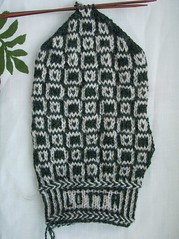A few months ago I promised my friend Lotta a pair of mittens. Now that the days keep getting shorter and cooler it's high time to get started!
I decided to try combining two knitting techniques, twined and stranded. The cuff is twined, which makes it stiff and dense, not very elastic - and I've discovered it's a technique that is great for knitting letters.
The main part is stranded, partly for elasticity, partly for warmth. I find twined knitting is more wind-proof, but stranded somehow warmer thanks to the floats. Or, rather, they're suitable for different kinds of weather.
The palm 
Twined stripes: ca 3.5/cm or 9/inch; stranded stripes: ca 3/cm or 7.5/inch. (In addition, the stranded stripes are elastic.) The gauge difference is rather remarkable; same yarn, same needles, same pattern and same number of stitches, but different techniques.

8 comments:
Gee, the mittens are beautiful. Lucky Lotta! I agree with you that the twined knitting takes letters very well. Do you use a formula for deciding how many stitches you have for the thumb? Once again, the photography is wonderful.
Ron in Mexico
So... is twined knitting different from the stranded stripes on the palm in the sense that you're twisting the yarns every stitch with the twined knitting? Or am I confused...
Ron: Thank you so much - I'm happy you enjoy my posts! When it comes to knitting thumbs:
1) For comfort I place the gusset a few stitches from the edge. How many depends mainly on gauge (and to some extent what the recipient's hands look like), in this case three.
2) I knit the wedge by increasing two stitches every two rows until it's about 2/3 of the thumb circumference. Depending on gauge I usually get 15-25 st. This one is 21 st wide.
Sometimes a pattern might be an important factor, so simply knitting stripes is an easy way out apart from other advantages!
You're not confused, Yarndude - that's the difference. I guess you could say in stranded knitting you keep the two strands in the same place, but in twined knitting they change places for every stitch. (Which makes it rather time-consuming...)
If you're interested in seeing what a twined wrong side looks like, I've posted some photos on Flickr; the easiest way to find them is to open the set "Twined knitting": flickr.com/photos/i-asplund
Hejsan! I'm not sure, but I don't think those notches can be avoided; from photos it looks as if even Anne-Maj Ling gets them, and if our Twined Guru does it says something. I'm going to contact her to buy z-plied yarn soon and I'll ask her about it. I do think twined braids look better after blocking even if the notches don't disappear.
How exciting about Twitter - not a member there - and thanks for your kind and flattering words about me there :D Tusen tack!
Oh, I love "Sakta" too - and I adore Zetterlund, have since I was a child. It's nearly impossible for me to choose a top favourte Z song, but it might be "Jag vet en dejlig rosa" from her album with Bill Evans. Do you know it?
Din veninde Lotta er heldig med at have en ven som du. :) Sikke nogle smukke vanter du har strikket til hende. De må bestemt varme både hendes hænder og hjerte. :)
Du gör så många fina arbeten. Tack för tipset att blanda stranded med tvåändsstickning.
Du har en award och en utmaning att hämta på min blogg.
Min kompis Lotta Björn brukar signera sina keramiska alster med
L8
Post a Comment